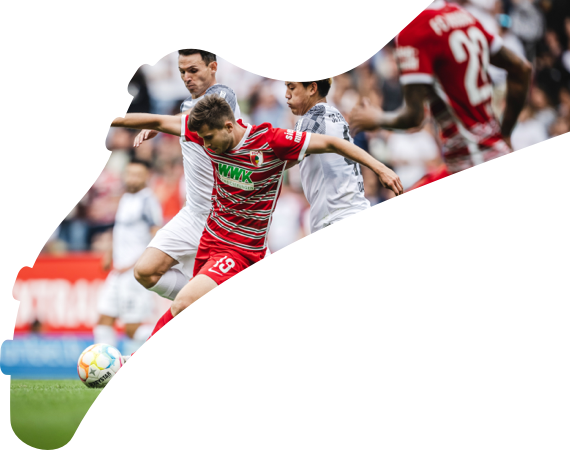Soccer positions explained: names, numbers and what they do
Football, soccer, the beautiful game… it's estimated that more than 250 million people play the sport in some capacity worldwide, but who is doing what, and where, when the 22 players take to the field?
From Manuel Neuer to Harry Kane, the German top flight boasts some of the best players in the world in their positions. bundesliga.com takes a closer look…
Position: Goalkeeper
- The most defensive position in soccer
- Main job to stop opposition goals
- Also organises the defence and builds play from the back
- Wears gloves, and a different coloured jersey from teammates
- Only player who can use their hands in their 18-yard box
Bundesliga archetype: Manuel Neuer
The best goalkeeper in the world, and arguably of all time. Neuer has the shot-stopping ability of anyone who has gone before him, but the term "sweeper-keeper" was effectively invented for the Bayern Munich man, who has revolutionised the position in a 17-year career which has brought 11 Bundesliga titles, two UEFA Champions Leagues and the 2014 FIFA World Cup with Germany.
On the rare occasions that his club or national team defences are breached, Neuer races off his line to quell the danger. When his team is in possession he is just as valuable, with distribution and technique honed from moonlighting in midfield in training. And for anyone who doubts that the 37-year-old is up to the traditional nitty-gritty of the position, it's worth remembering he has a record 204 shut-outs in the Bundesliga.
Watch: Neuer, a tactical revolutionary

Position: Full-back
- Lines up either side of the defence
- Marks opposition wingers
- Provides support for the wide midfielder ahead of them
- May overlap and send crosses into the opposition box
- Often takes throw-ins
Bundesliga archetype: Philipp Lahm
Philipp Lahm was Bayern captain before hanging up his boots in 2017, and had spent 15 years before that as the quintessential full-back in German, and indeed world, football. Neuer's teammate for club and country for much of that run, he too is a World Cup and Champions League winner, one who tallied 19 assists in the 2012/13 campaign.
Lahm was particularly attacking the year Bayern won their first continental treble, and Pep Guardiola later described him as "perhaps most intelligent player I have ever trained" on moving him into midfield later on, but Lahm broke through on the left of a back four before spending most of his career on the right of one, and none have done it better.
Position: Wing-back
- Modern variation of the full-back
- Overlaps and sends crosses into the opposition box
- Still marks opposition wingers when needed
- Expected to stay on their touchline
- One of the most physically demanding positions
Bundesliga archetype: Alphonso Davies
If anyone puts the "wing" in "wing-back", it's Canada superstar Davies. Bayern's 'Road Runner' started life as an out-and-out winger when he burst onto the scene with the Vancouver Whitecaps in Major League Soccer, before finding his feet further back at Bayern.
One of the fastest players ever seen in the Bundesliga, topping out at 22.69 mph, Davies' pace means he moves from touchline to touchline at a rapid rate. It allows him to cover defensive space and track oppositions wingers quicker than most players on the planet, as well as rapidly join Bayern attacks when they overturn possession.
Watch: Davies under the tactical microscope

Position: Centre-back
- Shuts down opposition attackers
- May employ zonal or man-marking strategies
- Brings the ball out from the back
- Often tall and physically strong
- Bravery and heading ability desirable, for use in either box
Bundesliga archetype: Mats Hummels
An asset on either side of the ball, Hummels and former long-time Bayern and Germany counterpart Jérôme Boateng redefined the central defensive role on approaching their collective peaks around the 2010 mark. Having initially made the move from Bayern to Borussia Dortmund in 2008, and back again in 2016, Hummels returned to the Signal Iduna Park three years later having played a critical role in keeping BVB at bay during his final season in Bavaria.
Normally operating from left centre-back, the right-footer has spun the ball to a teammate with a heat-seeking 91.3 per cent of his passes this season, even though he averages six progressive passes per game. The man who goes by Aussenrist - German for the outside of your foot - on social media has teed up 17 shots on the opposition goal. Tom Brady eat your heart out.
Position: Sweeper
- A safety net for the centre-backs alongside them
- Races to cover gaps when defence is breached
- Less concerned with man-marking
- Reads the game from deep
- Joins midfield build-up when in possession
Bundesliga archetype: Franz Beckenbauer
The sweeper position has made a comeback to a degree, teams dabbling with back threes more often than they have for much of the last 20 years, and the system often requiring a central player who can cover the defenders either side of him or carry the play into midfield, if not both.
But when back fours first ruled supreme, Franz Beckenbauer effectively invented the role, Der Kaiser bombing into midfield from defence for Bayern and Germany throughout the 1960s and 1970s. A key cog in three consecutive European Cups with Bayern and a World Cup with Germany, Beckenbauer is one of only two defenders - Fabio Cannavaro being the other - to have won the Ballon d'Or.
Position: Defensive midfielder
- Sits in front of the defence
- Wins the ball back with tackles and interceptions
- Covers teammates when they go forward
- Harries opposition attackers
- Physically fit and tenacious
Bundesliga archetype: Sami Khedira
Khedira broke through with hometown team VfB Stuttgart in 2006, and a year later they were Bundesliga champions. Seven more, by this time a midfield fulcrum for Real Madrid, he helped Germany to their World Cup triumph in Brazil in 2014.
Khedira scored 52 club goals in his career, which was testament to his ability in the final third, but most of his best work came at the other end, with Inverting the Pyramid author Jonathan Wilson perhaps best describing him as a "destroyer with carrying tendencies."
Position: Deep-lying playmaker
- Sits in front of the defence
- Creative playmaker from deep
- Distributes to teammates, near and far
- Sets the team's tempo
- Capable of tackling, though a secondary task
Bundesliga archetype: Thiago Alcântara
Father time is an undefeated champion, but Bayern's former midfield metronome Thiago was able to bend it to his will with unerring regularity using his speed of control, technique, and 20/20 distributive vision from the base of the champions' midfield. In his final season before joining Liverpool, Thiago completed 93 per cent of his passes at an eye-watering rate of 75 per game.
"It's Thiago or nothing," so said Guardiola on taking up the reins at Bayern in the summer of 2013. The current Manchester City coach got his man, and the Bavarians reaped the rewards for the next seven seasons.
Watch: How Thiago pulled Bayern's strings

Position: Central midfielder
- Lines up in the middle of the field
- Equally adept at attacking and defending
- Maintains possession
- Tracks back to tackle and block shots
- Breaks into the opponent’s box and tries to score
Bundesliga archetype: Lothar Matthäus
Lothar Matthäus was that rare player who was able to play more than one role to a world-class level. Germany's No.10 at Italia '90, he dropped deep in the final to man-mark Diego Maradona out of the game as West Germany beat Argentina 1-0 - but he was a sweeper by the time Bayern made it to the Champions League final in 1999, in which they were cruelly edged by Manchester United.
Matthäus was a box-to-box midfielder for most of his career, though, renowned for his perceptive passing, positional sense, well-timed tackles and powerful shot, often employed from the edge of the box. "He's the best rival I've ever had. I guess that's enough to define him," Maradona later said of Germany's 150-cap record appearance-maker.
Position: Attacking midfielder
- Dictates play from behind the strikers
- Creates goalscoring chances for the attackers
- Technique and creativity crucial
- Ability to shoot from range an advantage
- Historically associated with the No.10 jersey
Bundesliga archetype: Jamal Musiala
The classic No.10 was a string-pulling midfielder, typically with technique dripping from every pore, playing in the hole behind his team's central striker. They didn't always have to be the fastest - who can run quicker than the ball can move anyway? - imagination and creativity were key.
Today, the position is on the wane, with the attacking line expected to press from the front, but Jamal Musiala fuses old and new school interpretations better than most. Musiala still plays slick through-balls - his 13 assists last season were no accident - but 12 league goals also told the story of a No.10 who is just as happy to take as he is to make.
Watch: Musiala's creative dribbling

Position: winger
- The widest attacking player
- Takes on opposition defenders
- Provides crosses into the box
- Meets crosses from the opposite wing
- Often the fastest player on the field
Bundesliga archetype: Kingsley Coman
Few players represent wing play better than Bayern's flying Frenchman Kingsley Coman. With a top speed of 22.16 mph - one of the fastest ever seen in the Bundesliga - he has the speed to beat his man on the outside before whipping in a cross, but can also play on the opposite flank and cut inside on his stronger right foot, story told by 63 goals and 66 assists in his Bayern career to date.
Coman has won a league title in each of his 11 seasons as a professional: two with Paris Saint-Germain, one with Juventus and now eight on the bounce with Bayern, and came back to haunt PSG in the 2020 UEFA Champions League final, drifting in behind his marker from the left to meet Joshua Kimmich's cross from the right and head home a famous winner.
Position: Inverted winger
- Same, wide, attacking starting position as a conventional winger
- Takes on opposition defenders
- Cuts inside onto stronger foot to score or assist
- Push opposition full-backs onto their weaker sides
- Dribbling ability as important as pace in the role
Bundesliga archetype: Arjen Robben
There was scarcely a sight more iconic then Arjen Robben cutting inside from the right and steering a left-footed shot into the far corner of his opponents' goal. Everyone knew he was going to do it; nobody knew how to stop it. The Dutch wing wizard was used on the left when breaking through for PSV Eindhoven and the Netherlands as a youngster, with subsequent spells at Chelsea and Real Madrid just as likely to see him stationed on his natural side.
After joining Bayern in 2009, he made the right wing his own, though, with Robben and fellow inverted winger Franck Ribéry - collectively known as Robbery - stealing the show with 17 major honours won together. The fastest player in the world when clocked at just under 23 miles per hour at the 2014 World Cup, Robben didn't need that same top speed later in his career, with his ball control, trickery, and a dip of the shoulder taking on a greater importance.
Watch: Robben's Top 5 goals

Position False 9
- Starts up front near the opposition goal
- Replaces the traditional striker in most formations
- Drops deep to pull opposition defenders out of position
- Often a converted midfielder
- Dribbles and creates chances
Bundesliga archetype: Mario Götze
Maracanã Stadium, Rio de Janeiro, 13 July 2014, 5.43pm local time: "Show the world you are better than Messi and decide the World Cup" - Germany coach Joachim Löw to a 22-year-old Mario Götze…
Maracanã, Rio, 13 July 2014, 6.08pm local time: Götze, having replaced Miroslav Klose, steers home Andre Schürrle’s cross with an exquisite volley to lift Germany to a fourth World Cup at Argentina's expense.
The way Götze ghosted in between Martin Demichelis and Ezequiel Garay made him impossible to pick up. The centre-backs knew who was marking Klose, a natural striker, and when, all game. When Götze came on, he drifted between the lines of Argentina's defence and midfield. Float like a butterfly, sting like a bee. In a few short seconds, Argentina were floored.
Position: Forward
- Drifts into area between opposition midfield and defence
- Starts from similar position to No.10
- Provides assists and scores goals
- Elusive and difficult to mark
- More versatile than the target-man
Bundesliga archetype: Thomas Müller
To describe Thomas Müller as an archetype of any position might seem, on initial inspection, to be doing him down. The self-monikered Raumdeuter, Müller's style has left pundits - and indeed defenders - perplexed for years.
However, his coaches and teammates could hardly hold him in higher regard. The Bayern icon allegedly lacks a bit of technical skill, but his awkward gait belies an ability to control the ball that few can match. No ordinary player could bag 10 goals across two World Cups, while 145 Bundesliga strikes and 202 assists tell their own story.
Watch: Müller, the best in the world without the ball?

Position: Striker
- Closest player to the opponent's goal
- Responsible for scoring goals
- Holds the ball up until teammates can join the attack
- Harries opposition defenders
- Physically strong
Bundesliga archetype: Harry Kane
From Gerd Müller to Robert Lewandowski, Bayern and the Bundesliga have boasted some of the best strikers the game has ever seen, but few compare with Bavarian new boy Harry Kane, who joined from Tottenham Hotspur last summer in what was a record transfer for both clubs.
Kane remains on course for Lewandowski's single season Bundesliga record of 41 goals scored in 2020/21, with his 21 so far plundered at a rate of one every 63 minutes he has played with 1,710 mins still available in the current campaign.
Already the record scorer for Tottenham and England, the latter of whom he captains, Kane is also able to drop deep and play as a 9.5, teeing up others with his vision and passing accuracy. That Leroy Sané has nine goals this season, four of them assisted by Kane, is no accident.
Watch: A closer tactical look at Harry Kane



